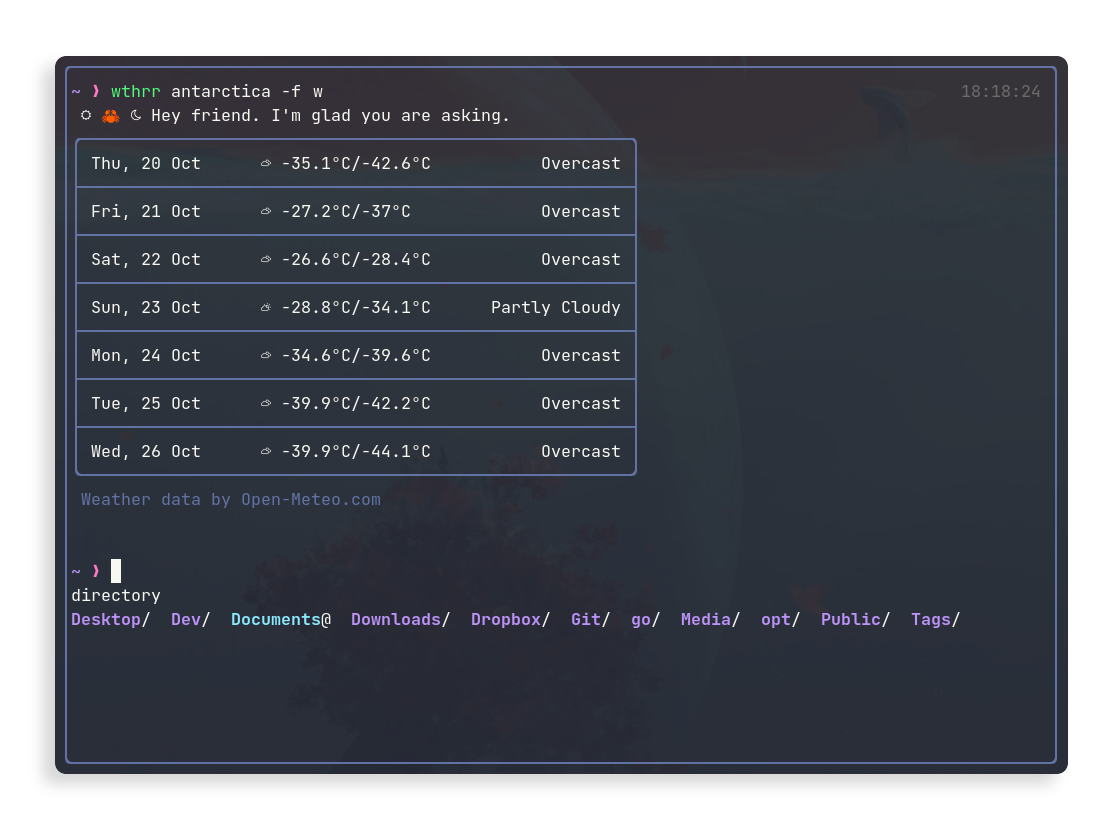wthrr lives in your terminal and her passion is meteorology.
If you spend time in the TUI, you'll have a little companion nearby who knows about the weather.
Just call
wthrr
Without having added an address or options, wthrr uses the config saved as default.
If you haven't configured anything as default yet, wthrr can try to search for a weather station near you and save the searched location as default.
It's always possible to specify an address. E.g.,
wthrr melbourne
Depending on the place you are looking for, you might need to be more specific.
For example, the above call will get Melbourne in Australia. If you are aiming for Melbourne in the US, ask for melbourne,florida.
If the address contains spaces, separate them with a hyphen or enclose them in quotation marks (e.g., new-york or "new york").
To search explicitly for a weather station in the vicinity, call
wthrr auto
As a final example, we instruct wthrr to use Fahrenheit and mph as units and add the hourly forecast for the day
wthrr -u f,mph -f d
> wthrr -h
Usage: wthrr [OPTIONS] [ADDRESS]
Arguments:
[ADDRESS]
Address to check the weather
Options:
-f, --forecast <FORECAST,...>
[e.g.: -f w,d] [possible values: disable, (w)eek, to(d)ay, (t)omorrow, mo, tu, we, th, fr, sa, su]
-F, --historical-weather <%Y-%m-%d,...>
[e.g.: -F 2021-12-31]
-u, --units <UNIT,...>
[e.g.: -u f,12h,in] [possible values: (c)elsius, (f)ahrenheit, kmh, mph, (kn)ots, ms, 12h, 24h, %, mm, (in)ch]
-l, --language <LANGUAGE>
Output language [e.g.: en_US]
-s, --save
Save the supplied values as default
-r, --reset
Wipe wthrr's configuration data
-h, --help
Print help
-V, --version
Print version
| First Run | Hourly Forecast |
 |
 |
| Week Forecast | *Terminal Colors |
 |
 |
*Rendering and colors are influenced by the terminal used and its theme and font.
E.g., the first of the above screenshots show wthrr in nvim(toggleterm) using kitty as terminal with a Dracula theme and JetBrainsMono Nerd font. The last screenshot shows wthrr in Yakuake/Konsole, also with a Dracula color scheme.
The address, units and default forecast can be saved as default values in wthrr's config file by adding the -s flag to a run. This will save the config in wthrr.ron.
Platform locations:
Lin: ~/.config/weathercrab/
Mac: ~/Library/Application Support/weathercrab/
Win: %USERPROFILE%\AppData\Roaming\weathercrab\
Default values
(
address: "", // Address to check the weather, e.g.: "Berlin,DE"
language: "en_US", // Language code of the output language
forecast: [], // Forecast to display without adding the `-f` option: `[day]` | `[week]` | `[day, week]`
units: (
temperature: celsius, // Temperature units: `celsius` | `fahrenheit`
speed: kmh, // (Wind)speed units: `kmh` | `mph` | `knots` | `ms`
time: military, // Time Format: `military` | `am_pm`
precipitation: probability, // Precipitation units: `probability` | `mm` | `inch`
),
gui: (
border: rounded, // Border style: `rounded` | `single` | `solid` | `double`
color: default, // Color: `default` | `plain`
graph: (
// Graph style: lines(solid) | lines(slim) | lines(dotted) | dotted | custom((char; 8))
// `custom` takes exactly 8 chars. E.g. using a set of 4 chars: `custom(('⡀','⡀','⠄','⠄','⠂','⠂','⠁','⠁'))`,
style: lines(solid),
rowspan: double, // Graph height: `double` | `single`
time_indicator: true, // Indication of the current time in the graph: `true` | `false`
),
greeting: true, // Display greeting message: `true` | `false`
),
)Use rusts package manger to install wthrr.
From crates.io
| Version | Command |
| release | cargo install wthrr |
| development | not available |
From git source
| Version | Command |
| release | cargo install --git https://github.com/ttytm/wthrr-the-weathercrab --tag v1.1.1 |
| development | cargo install --git https://github.com/ttytm/wthrr-the-weathercrab |
Requirements and alternative, platform-specific installation instructions can be found in INSTALL.md.
Important To display symbols correctly, the used terminal must be configured to use a NerdFont.
The issues section lists some of the features that are being worked on.
Contributions like 🐛bug reports, ⭐️stars and 💡suggestions are welcome alike!
A simple changelog can be found on the releases page.
- The app uses the open-source weather API for non-commercial use provided by Open Meteo




